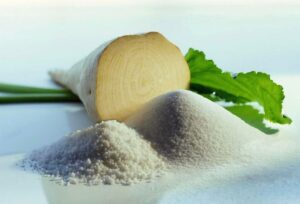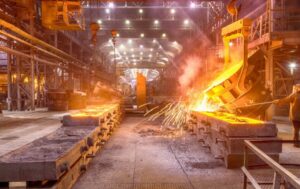
The production of bio-glue from peas, which is necessary for the manufacture of eco-friendly wood panels for the construction and furniture industries, has started in the Korosten Industrial Park (Zhytomyr region), invested in by the Korosten MDF Plant owned by businessman Leonid Yurushev and his family.
“A unique production facility has started operating in the Korosten Industrial Park in Zhytomyr region. It has launched the production of bio-glue from peas. The total investment in this project is EUR 40 million,” wrote Dmytro Kysilevsky, deputy chairman of the Verkhovna Rada Committee on Economic Development, on Facebook.
He stressed that the launch of such production is sensational news for the Ukrainian agricultural sector, since the demand for new production is 1 million tons of peas per year, which is more than twice the gross harvest of this crop in 2024. Therefore, until Ukrainian farmers increase the area under this crop, part of the production needs will be covered by imports from Hungary and Poland.
According to him, the investor of the Korosten MDF Plant project is currently consulting with farmers in the Zhytomyr, Kyiv, Cherkasy, Kirovohrad, and Dnipropetrovsk regions on expanding the acreage and long-term contracts for the supply of peas.
“The climate in these regions allows for two pea harvests per year,” Kysilevsky added.
The new plant’s design capacity is 3,000 tons of bio-glue per month, with planned production volumes of eco-boards at 20,000 cubic meters per month.
To implement the project, the investor took advantage of the opportunity to import equipment without paying VAT, which is provided for by law for participants in industrial parks.
The MP recalled that last fall, IP Korosten, as part of a state project to develop the infrastructure of industrial parks on a 50/50 co-financing basis, attracted UAH 83.5 million from the state for the construction of an access road.
“At the same time, a similar enterprise, Korosten MDF Plant, is building in the BF Terminal industrial park (Zakarpattia region). 90% of eco-boards are planned to be exported. These products comply with EU regulations, which, from August 6, 2026, will tighten the requirements for formaldehyde content in adhesive mixtures for MDF and HDF board manufacturers,” Kysilevsky said.
He recalled that IP Korosten covers an area of 42.2 hectares and brings together a cluster of woodworking companies, including Ukrainian Holding Sawmill Company, Rezalt Eco, Korosten MDF Plant, BF Engineering, and BF Project.
According to YouControl, Korosten MDF Plant ended 2024 with a loss of UAH 9.8 million, while in 2023 it received a net profit of UAH 237 million, and its net income decreased by a quarter to UAH 1.89 billion. In January-September this year, its loss amounted to UAH 18.4 million, and its revenue was UAH 1.46 billion.

Serhiy Ustenko, owner of the Carpathian Mineral Waters group, signed a €11 million loan agreement with the European Bank for Reconstruction and Development (EBRD) during the ReBuild Ukraine 2025 conference in Warsaw, according to a Facebook post by the National Association of Extractive Industries of Ukraine.
“The investment will be used to build a modern, energy-efficient beverage production plant in Lviv region, which is an important contribution to Ukraine’s food security and the development of sustainable production,” the statement said.
It is expected that, as part of the implementation of an inclusive employment model, the company will create at least 50% of jobs for veterans and people with disabilities.
“The financing will allow us to expand our production capacity and make our business even more environmentally friendly and socially responsible. Thank you for investing in the development of KMW and food security in Ukraine,” Ustenko said, thanking the EU and the EBRD for their trust and support.
The association recalled that Karpatski Mineralni Vody purchased a special water permit for a new plant near Zolochiv. The company paid UAH 26 million for the plot at auction.
According to the Karpatski Mineralni Vody website, the company began operating in the mineral water market in 1996 with the first bottling of Karpatskaya Dzherelna natural mineral table water. In June 2002, it was reorganized into a plant for the production of mineral water and non-alcoholic beverages, Karpatski Mineralni Vody. At the same time, the company began producing sweet carbonated drinks under the Fruktova Dzherelna and Sokovinka brands, and in 2016, the Dragon energy drink.
CONSTRUCTION, EBRD, KMW, PLANT

According to Serbian Economist, Chinese automaker Chery is discussing with the Serbian government the possibility of opening a production plant in Serbia. In Shanghai, Serbian Deputy Prime Minister and Economy Minister Adriana Mesarovic held talks with Chery Chairman Yin Tongyue, the parties discussed the conditions of potential localization and further steps, Serbian publication Telegraf reported, citing Mesarovic’s statement.
According to the minister, Serbia’s status as a “gateway to Europe” and the free trade agreement with China create additional opportunities for investors, including access to a number of trade agreements when localizing more than 51% of the value added of products. Mesarovic also said that she expects Chery’s head to visit Belgrade to continue negotiations.
Specific parameters of the investment project, terms and location were not disclosed.
In 2025, Serbia has already announced a project for the construction of an electric car plant of Chinese JMEV in Sremska Mitrovica with export orientation to the EU market. Against the backdrop of the expanding presence of Chinese carmakers in the region, Chery is developing its European sales network and localization initiatives in parallel.
https://t.me/relocationrs/1699

The sugar factories of Astarta, Ukraine’s largest sugar producer, have processed 1.2 million tons of sugar beets since the start of the sugar season, according to the agro-holding’s press service.
“The sugar season continues! Astarta’s sugar factories have already processed 1.2 million tons of beets,” the agricultural holding company said on Facebook.
Astarta did not report on the volume of sugar produced, but specified that the harvesting campaign is currently underway in the agroholding’s fields.
Astarta and its structural unit Astarta Agro Protein signed the first investment agreement with the Ukrainian government to receive compensation from the state for significant investments. Under the agreement, the state will provide the agricultural holding with a number of incentives, including exemption from import duties on new equipment, import VAT on new equipment, and income tax for up to five years.
Astarta is a vertically integrated agro-industrial holding company operating in eight regions of Ukraine and is the largest sugar producer in Ukraine. It comprises six sugar factories, agricultural enterprises with a land bank of 220,000 hectares, dairy farms with 22,000 head of cattle, an oil extraction plant in Hlobyn (Poltava region), seven elevators, and a biogas complex.
In the first half of 2025, Astarta reduced its net profit by 10.3% to EUR47.11 million, and its consolidated revenue decreased by 29.3% to EUR320.71 million.
On June 12 this year, the shareholders’ meeting approved the payment of dividends for 2024 in the amount of EUR0.5 per share for a total of EUR12.5 million, which is in line with the figures for the previous two years.

In January-September of this year, PJSC Nikopol Ferroalloy Plant (NFP, Dnipropetrovsk region) increased its net loss by 86.1% compared to the same period last year, from UAH 1 billion 81.463 million to UAH 2 billion 12.843 million.
According to the NPF’s interim report, net income for this period decreased by 21.4% to UAH 5 billion 111.026 million from UAH 6 billion 500.004 million.
Undistributed profit at the end of September 2025 amounted to UAH 2 billion 281.398 million.
As reported, in 2024, NZF increased its net loss by 15.9% compared to 2023, to UAH 3 billion 35.966 million from UAH 2 billion 620.399 million. Net income for the past year decreased by 17.7% to UAH 7 billion 813.056 million from UAH 9 billion 493.059 million.
In addition, it was reported that the Pokrovsky Mining and Processing Plant (PGZK, formerly Ordzhonikidze Mining and Processing Plant) and the Marganetsky Mining and Processing Plant (MGZK, both in Dnipropetrovsk region), which are part of the Privat Group, stopped mining and processing raw manganese ore at the end of October-beginning of November 2023, while NZF and ZZF stopped smelting ferroalloys. In the summer of 2024, ferroalloy plants resumed production at a minimum level.
NZF is Ukraine’s largest producer of silicon and ferromanganese. The average monthly output of ferroalloys during stable operation of the enterprise is about 55-60 thousand tons.
According to NDU data for the first quarter of 2025, Sofalon Investments Limitad owns 15.503% of the shares of PrJSC, Rougella Properties Ltd. – 9.6904%, Dolemia Consulting Ltd. – 15.7056%, Sonerio Holdings Ltd. – 9.2158%, Manjalom Limited – 5.8824%, Treelon Investments Limited (all – Cyprus) – 15.1013%.
The authorized capital of PJSC NZF is UAH 418.915 million.
NZF is controlled by the EastOne group, created in the fall of 2007 as a result of the restructuring of the Interpipe group, as well as the Privat group (both based in Dnipro).

In 2024, PJSC Nikopol Ferroalloy Plant (NFP, Dnipropetrovsk region) increased its net loss by 15.9% compared to 2023, from UAH 2 billion 620.399 million to UAH 3 billion 35.966 million.
According to NZF’s annual report, net income for the past year decreased by 17.7% to UAH 7 billion 813.056 million from UAH 9 billion 493.059 million.
Retained earnings at the end of 2024 reached UAH 4 billion 128.280 million.
As reported, in January-June of this year, NZF reduced its net loss by 69.6% compared to the same period last year, to UAH 458.274 million from UAH 1 billion 505.962 million. In the first half of 2025, NZF increased its net income by 11.7% to UAH 3 billion 915.368 million from UAH 3 billion 505.483 million. Undistributed profit at the end of June 2025 reached UAH 3 billion 778.047 million.
In 2020, the company received a net profit of UAH 456 million 162,764 thousand. In 2021, the company received a net profit of UAH 5 billion 139 million 528,911 thousand. In 2022, NZF received a profit of UAH 910 million 452,147 thousand.
The plant ended 2023 with a net loss of UAH 2 billion 620 million 398,599 thousand.
In addition, it was reported that the Pokrovsky Mining and Processing Plant (PGZK, formerly Ordzhonikidze Mining and Processing Plant) and the Marganetsky Mining and Processing Plant (MGZK, both in Dnipropetrovsk region), which are part of the Privat Group, ceased the extraction and processing of raw manganese ore at the end of October-beginning of November 2023, while NZF and ZZF stopped smelting ferroalloys. In the summer of 2024, ferroalloy plants resumed production at a minimum level.
The business of ZZF, NZF, Stakhanovskyi ZF (located in NKT), Pokrovskyi and Marganetskyi GZK was organized by Privatbank prior to nationalization.
NZF is Ukraine’s largest producer of silicon and ferromanganese. The average monthly output of ferroalloys during stable operation of the enterprise is about 55-60 thousand tons.
According to NDU data for the first quarter of 2025, Sofalon Investments Limitad owns 15.503% of the shares of the private joint-stock company, Rougella Properties Ltd. owns 9.6904%, Dolemia Consulting Ltd. owns 15.7056%, Sonerio Holdings Ltd. holds 9.2158%, Manjalom Limited holds 5.8824%, and Treelon Investments Limited (all based in Cyprus) holds 15.1013%.
The authorized capital of PJSC NZF is UAH 418.915 million.
NZF is controlled by the EastOne group, created in the fall of 2007 as a result of the restructuring of the Interpipe group, as well as the Privat group (both based in Dnipro).
FERROALLOY, LOSS, NIKOPOL, PLANT, НЗФ